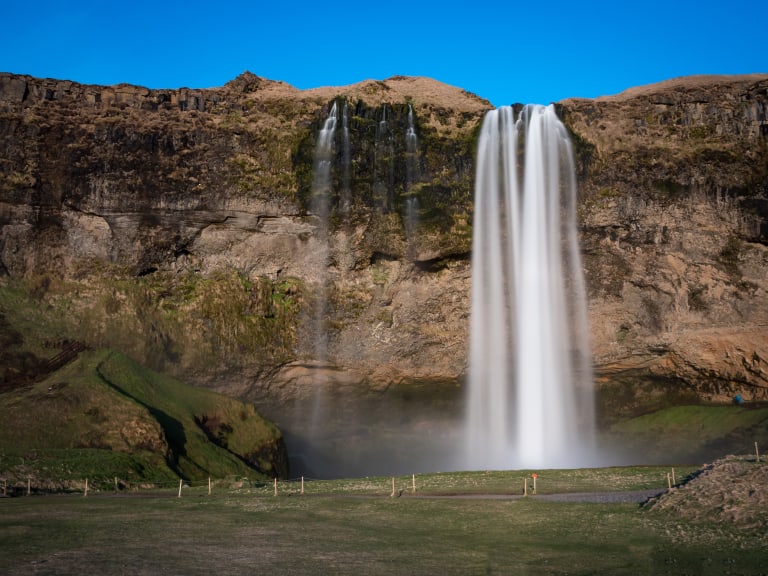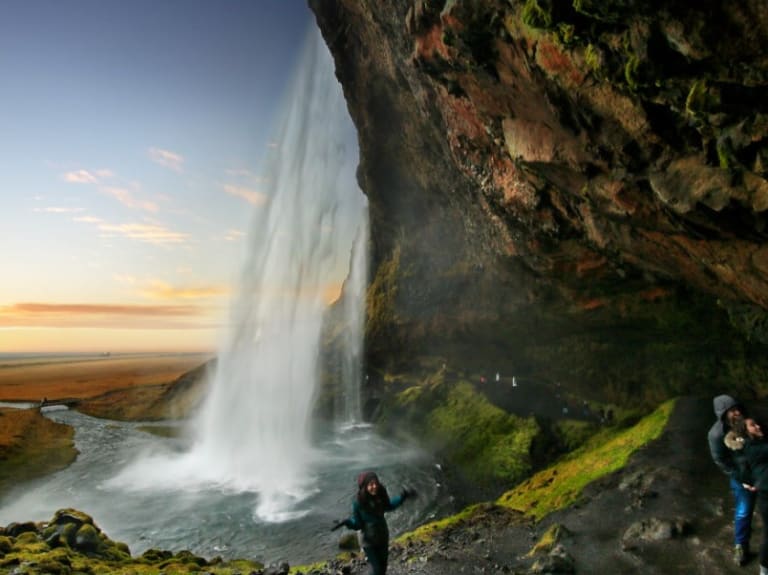More about: Seljalandsfoss Waterfall Day Trips in Iceland
Iceland is famous for its beautiful landscapes, but also for its wide range of adventure experiences. Whale watching, geyser tours, helicopter tours: there are thousands of things to see and do in and around Reykjavik.
This article focuses on one specific attraction: the Seljalandsfoss waterfalls. They are located a short distance from a main road and therefore one of the most visited attractions on the island.
1. South coast route with stage to Seljalandsfoss

These tours cover the southern part of the island and include a stop at the Seljalandsfoss waterfall. The tour usually stops at this point for about half an hour and is the last stop before returning to Reykjavík.
Before arriving at the waterfalls, the vehicle stops at:
- Hekla, Iceland's most active volcano. Its regular eruptions have earned it the nickname "Hell's Gate". Despite its terrifying name, it is not uncommon to see splendid Icelandic horses in the surrounding area. They are different from the European specimens: they are small, strong and at the same time very affectionate. If you want to meet them, I recommend you to read the article about the best horseback riding tours in Iceland.
- Reynisfjara, a striking black sand beach with a cliff of basalt columns, is so beautiful that it looks fake! In this splendid spot nests the Puffin or Atlantic puffin. These small white-breasted black birds are much loved and there are excursions to see them up close. One of these is the Puffin Cruise from Reykjavik.
- Skógafoss, the waterfall that hides a treasure. According to local folklore, the navigator Thrasi hid his chest here and never returned to retrieve it.
- Eyjafjallajokull, the volcano with an unpronounceable name that kept the whole of Europe in check. Its last eruption took place in 2010 and covered the skies of the old continent with a layer of ash. If you are not very young, you may remember that planes did not take off for a week.
- Solheimajokull, the most beautiful glacier in the southern area. It is also one of the most easily accessible glaciers from Reykjavik.
Normally, these routes include a stop at Víkurskáli, a mini market where you can buy something for lunch: soups, cheeses, sausages, crackers, etc.. The stop usually lasts about an hour.
- Price: about 90 €.
- Duration: 10 hours
- Starting point: the vehicle will pick you up at your hotel or at a central location in Reykjavik.
2. Seljalandsfoss, Skógafoss, Black Beach and Solheimajokull

At first glance, this route is the same as the first one. Indeed, the differences are minimal, but there is a town that is only touched by choosing this second option: Vík í Mýrdal, a picturesque village overlooking the sea. It is not only a suggestive place, but also a stage to refuel, rest and eat something.
Its icon is the minimalist (and very photogenic) red and white church that dominates the inhabited center from a small height. If you have time, you can have a pint and a burger at the Strondin pub (Austurvegur 18).
- Price: more or less 100 €.
- Duration: 10 hours
- Starting point: from your hotel
How to get to Seljalandsfoss waterfalls

The waterfall is located on the south coast of the island, about 120 kilometers from Reykjavik. In case you do not want to book an organized tour, you have only one option: the car. Buses are limited to connecting towns and villages and do not usually stop near the natural attractions.
Not a problem, both the airport and the capital are home to the main rental agencies (Europcar, Hertz, Sixt, etc). The waterfall is located just off the Ring Road and the drive takes just under 2 hours. One last thing, before booking a vehicle you should keep in mind a few tips:
- Consider renting a 4x4, especially if you plan to explore the more remote areas.
- Extend your insurance coverage. Most of the roads are gravel and a small rock splash is enough to damage the bodywork or, even worse, the windshield.
- Don't wait too long to refuel. Outside the capital, gas stations are rather scarce. Fortunately, near Seljalandsfoss there is an N1 gas station (PQX8+RFM, Þjóðvegur, 860 Hvolsvöllur, Iceland).
- Respect the limits. The main road (Ring Road) is full of speed cameras. If that's not enough, sheep and horses often invade the roadway.
When is the best time to visit the waterfalls?

There are two schools of thought: some believe that the best time is winter, others consider it worthwhile to visit the waterfalls from late May to early July, when the waterfall is more consistent and there is a better chance of seeing the aurora borealis.
However, the colder months have a plus point, the snow. The contrast with the dark rocks and stalactites of solidified water creates a very suggestive atmosphere.
Unfortunately you will not be able to walk behind the waterfall. The path is too slippery and the authorities have no choice but to close it.
Despite the low temperatures, the falls do not freeze completely. Falling from the top of the cliff, the water makes its way between icy banks covered with a beautiful white coating.
In case you are traveling to Reykjavík in winter, you will be pleased to know that the roads leading to Seljalandsfoss are cleaned regularly. In any case, you can check the condition of the "Ring Road" (the highway around the island) and other roads on the Road.is website.
How long is it worth staying at Seljalandsfoss?

In general, half an hour is enough. Unlike other natural attractions in the country, this waterfall is easily accessible by car and there is no real hiking trail.
Most tourists get here, take a few pictures, loiter a bit and then leave. If you're looking for something longer, you can book a tour to the Blue Lagoon from Reykjavik or a visit to Thingvellir National Park.
How should I dress?

A hike in the wilderness always involves a little challenge. You have to be ready for any eventuality and the best advice is always the same: dress in layers. To simplify matters, I've divided the suggestions into two points.
Summer clothes
In Iceland, summer starts in June and ends at the end of August. The days are very long: sunrise is very early and sunset never seems to come. As for temperatures, the minimum temperature is around 10º while the maximum is around 20º. The weather is very variable and, as always, requires varied clothing:
- Breathable and water-repellent pants (not too heavy or you will get hot).
- Trekking shoes
- Short and long sleeved shirts (to have two layers)
- Light coat
- Windbreaker jacket with hood
- Earmuffs
- Sunglasses
If this is your first time in Iceland, it might be better to choose this season. For more information, I recommend the article explaining what to do in Reykjavik in summer.
Winter clothes
Normally, the cold season starts in November and ends at the beginning of April. Contrary to what you may think, temperatures are not extreme. In Reykjavík, minimum temperatures do not go below - 5º while maximum temperatures reach "peaks" of 3º/5º.
However, the wind is a constant and increases the feeling of cold. In order not to suffer from it, you should prepare your suitcase well. The list below lists what you should not miss:
- Thermal underwear in merino wool or polypropylene, it is better to avoid cotton.
- Waterproof trekking shoes or winter boots.
- Waterproof and windproof ski pants
- Neck warmer, more practical than a scarf
- Woolen hat
- Quality winter jacket
- Fleece coat
- Ski gloves and tactile gloves
If you are traveling at this time of year, you can take the opportunity to buy a Lopapeysa, the island's warm sweater. You'll find a good selection at the Handknitting Association of Iceland (Skólavörðustígur 19) or the Kolaportið Flea Market (Laugavegur 12).
Is it possible to swim in Seljalandsfoss?

By proxy you can, but it's not a good idea. The impact of the water is too strong and I'm sure you don't want to find out the consequences. If you want to take a dip, I recommend visiting Iceland's best hot springs- you'll be reborn again!
Do I need travel insurance to visit Seljalandsfoss?

A hike to the waterfalls is fairly straightforward: it doesn't require too much effort or involve significant dangers. However, Iceland is an adventure destination and unforeseen events are always lurking. Without travel insurance, a sprained ankle or infection could become a headache (metaphorically).
The northern country does not belong to the European Union and the EU card is valid to a point. Icelandic citizens are obliged to pay 15% of any health care and if you don't take out additional insurance, you will be subject to the same treatment.
In short: it's worth spending a little more to travel with peace of mind. This way, you will be able to go on all the adrenaline activities you feel like: horseback riding tours from Reykjavik, hiking through the ice caves, mountain biking and much more.
Is there a bar or restaurant near the waterfalls?

No, Seljalandsfoss is close to the road but there are no major towns or cities in the vicinity. Whether traveling alone or on an organized tour, I recommend that you bring food and/or drink from the capital. In Reykjavik, the main supermarkets are:
- Bonus, the cheapest on the island. Do not go if you want to make a large purchase because the selection is limited.
- Hagkaup, a bit more expensive but with supermarkets open 24/7.
- Iceland, the ideal destination if you like sweets. During the weekend there is a pick and mix option that guarantees a 50% discount on these products.













